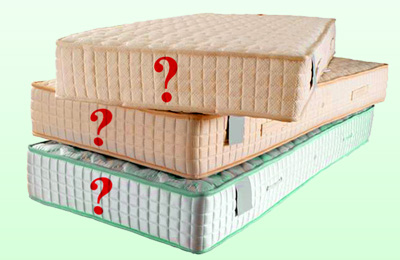Mattress Name Game – A deceiving tactic of the mattress industry

Are you confused and irritated with so many mattress names? One of the most annoying practices inherent to the mattress industry is the fact that an identical mattress is marketed under several different model names depending on the retailer carrying it. Consider this scenario: You are excited to buy a new bed and you have a plan – visit 2 stores and go online. After spending all Saturday morning lying on beds and surfing the web you are more confused than before. You find a model that you like from Brand X in one store for $1500 and a different model from Brand X for $2000 in a different store down the street. Meanwhile, online searching yielded a third model from Brand X for $1000. Try as you might, you cannot find a single significant difference between the three models. Searching for the various model names online is exhausting but mostly useless. So how could that be?
Mattress Name Game
Surprisingly, the answer is that you were likely interested in the exact same mattress, but under different names, at each of those three stores. Referred to as Mattress Name Game, this practice has been going on for decades. It is a tactic used by mattress retailers to keep customers from comparison-shopping, thereby keeping their profit margins inflated. Retailers and manufacturers alike purposefully provide limited product information on labels, price tags or online sources to keep you from doing your due diligence.
All mattress models of a particular manufacturer are made at the same factory, yet assigned different names depending on which retail store they are being shipped to. There are typically superficial differences, such as top material color and pattern, but the construction, major features, and overall feel remain identical. Technically, retailers can claim they have a unique model with a unique name by applying these minor changes. Unfortunately, almost every major player in the mattress industry resorts to the name game, so the same mattress will have numerous names along with different prices, both in-store and online, making it practically impossible to compare.
Store “exclusive” mattress lines
On top of this, because the major retail outlets have enormous purchasing power, they get an “exclusive” product line made for them specifically and not available at other stores. This “exclusivity” is based on a different name and rather insignificant changes to the cover material and pattern, along with different names of foam layers (SuperSoft foam vs. UltraGentle) and possibly a negligible thin layer of foam to create an “obvious” distinction. Again, the support system, major features, premium layers, warranty and overall feel are the same. This trick allows retailers to sell you on their own “personalized” line, claiming it is better than the basically identical mattress from their competitors.
This whole process serves one and only purpose, and that is to confuse customers and discourage them from shopping around for a better mattress and a better deal. It is one of the reasons why we endeavored to create this website - to empower anybody who wants to research and compare models and brands without all the hassle. We encourage you to concentrate on, and compare the inner components of mattresses, rather than looking at the particular product names.
Lowest price guaranteed
You probably have seen it a thousand times on local TV and in the Sunday paper – advertising claims by mattress stores to beat anybody’s price on the same product, or guarantee the lowest price. As you probably figured by now, with the unique names and exclusive product lines, these advertising claims are just empty promises. Or aren’t they? Well, that entirely depends on you. Once you learn how to crack the code of the mattress name game, you will be in a much better position to not only find a great mattress, but also negotiate a great deal.
Believe it or not, mattress stores, with their “Beat any price” and “Lowest price guarantee” claims actually provide one of your most powerful negotiating tools. After all, most mattress sales people are paid on commission and NEED to make a sale in order to make money. If you ask for a comparable model to one you have previously seen, the sales person might show you an inferior product hoping you are not aware of the complete specs (it happens all the time). But, if you do your homework and know which product is actually comparable for a lower price, they will take the deal.
Cracking the code
When comparing mattresses, it is important not to get hung up on names, colors and cover patterns. Instead of looking at a single mattress, focus your attention on a mattress line – a group of mattresses with the same construction and features, but with different softness. Manufacturers generally make one softness variation for each line. So, you can find Brand X with Product Line Y and models A firm, B plush, C pillow top. These mattresses are the same at the different stores under Brand X, Product Line Y and model names K firm, L plush and M pillow top.
Once you select a certain product, make sure you jot down all of the information that is crucial in order to compare it to a product at a different store: cover and ticking, comfort or padding layers, any premium materials (memory foam, latex, gel…), support system and its components, warranty and exchange policy. By clearly establishing your benchmark, you can now shop around and compare these particular components to each other. Eventually, you will be able to match up the models with different names and see how they relate to each other and instead of worrying about the product, you can focus on where to buy it (depending on store services and policies) and negotiate a good deal.
Read about mattress shopping process here
